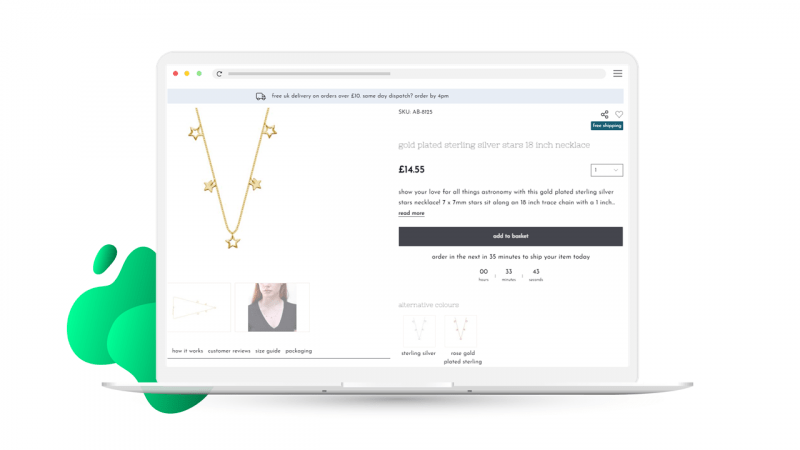Capturing hearts and carts, personalized marketing is undeniably the secret sauce for staying competitive and nurturing meaningful customer relationships. But how can brands wield this powerful tool to influence buying behavior without crossing the line into unethical territory? By discovering the art of guiding consumers ethically using popularity, scarcity, and social proof, businesses can create trust and loyalty, paving their way to ecommerce success. Let’s delve deeper into balancing marketing persuasion with ethical responsibility, a vital component for building lasting relationships in today’s ever-evolving online marketplace.
How ethics fits into personalized marketing
An important aspect of personalization is the design of different ways in which choices can be presented to decision makers, and the impact of that presentation on decision-making. It was first discussed by Richard Thaler and Cass Sunstein in their 2008 research into how decision-making is influenced by the way options are presented and called “Choice Architecture”
As a marketer working in personalization, I find Choice Architecture’s impact on customer experience very interesting. Personalized marketing creates interactions that are more relevant and engaging to customers. It boosts conversion rates, encourages repeat business, provides insights for strategic decisions, and increases sales and average order values by presenting shoppers with relevant upsell and cross-sell offers.
Today’s ecommerce marketers have access to sophisticated personalization tools equipped with artificial intelligence, machine learning and advanced analytics to help shoppers discover and buy products quickly and easily. More than that, marketers have decades of behavioral science research to help guide their decisions on fonts, colors, imagery, and navigation.
In the end, though, it all comes down to a marketer’s intentions. What’s the motivation behind your personalization strategy? Is it to reduce friction in the shopping experience and create a better customer outcome? Or is it to generate conversions at any cost?
Personalization for a better user experience versus manipulation is the question the Competition and Markets Authority (CMA) began digging into in 2022 as part of its much larger exploration of how online choice architecture can push consumers to make choices they might not otherwise make. In March, the CMA issued guidance on urgency and price reduction claims — social proof tactics commonly used in ecommerce marketing.
The agency’s guidance highlights the importance of authenticity, honesty, and transparency — ideals Fresh Relevance and its clients are deeply committed to. In this post, we explain our understanding of the CMA’s guidance, share best practices for using urgency and price reduction claims, and show some examples of our clients’ work illustrating the guidelines in action, offering a blueprint for your own campaigns. Nothing in this post should be taken as legal advice, and you need to carefully review the CMA guidance to ensure that you are complying with the law in the UK and other territories where your business operates. We advise obtaining advice from your legal counsel in case you have any questions about your compliance with the CMA’s guidance.
Transparency in urgency claims
Incorporating urgency into your marketing interactions can be a powerful motivator. The CMA defines an urgency claim as “any scarcity, popularity, ‘act fast’ or time-limited claim that is presented to consumers online.”
Timers, scarcity, availability, popularity, and reviews and ratings should accurately reflect the truth to protect your brand, build trust with your customers, and ensure compliance with the CMA’s guidance. We recommend real-time tracking of stock levels and time-sensitive offers, ensuring that any urgency claim you make is based on factual, up-to-date information. This approach helps with complying with legal standards and builds consumer trust.
Cooksongold
Popularity messaging
This product listing page is a great example of popularity messaging and availability data to validate the purchase decision. Cooksongold has prominently displayed the number of people who’ve previously purchased the product, its ratings and reviews, and whether or not it’s in stock — reducing the frustration of unknowingly carting an out-of-stock item.

Jewellerybox
Act fast, shipping countdown timer
Use a countdown timer like this one from Jewellerybox to catch your reader’s eye and tempt them into converting. This example helps improve the customer experience by showing a dynamic view of the shipping timeline they can expect, if they act immediately. In an age where convenience is so important, showcasing the expected shipping timelines can help not only manage expectations but also encourage conversions.
You can also use countdown timers in bulk and triggered emails and in your app. In emails, countdown timers can be generated as a GIF at the moment a shopper opens the email. Countdown timers are a great way to build excitement for an important deadline, such as the end of a promotion. The messaging can be personalized – based on the event or the individual customer. You must ensure that the deadline is genuine and truthful.

Authenticity in ratings and reviews
Buyagift
Limited-time claim, countdown timer, ratings and reviews, popularity
Buyagift has seen a 13% increase in sales since implementing product ratings and other high converting social proof tactics in its’ automated emails.
Consider adding star ratings alongside product recommendations to pique shoppers’ interest and encourage click throughs. Be sure to filter those recommendations by a minimum star threshold to ensure you showcase your top performers, but make sure that your claimed ratings are genuine and not deceptive. Buyagift boosts the conversion rate of their automated discount emails by showing ratings alongside each experience and product promoted.

Honesty in price reduction claims
Price reductions, sales, and discounts are a common ecommerce strategy. The CMA defines a price reduction claim as “any discount or special offer price that refers to a higher comparison price.” There is nothing unethical about a sale or discount — everybody loves a good deal! It gets sketchy when you claim the price was reduced just to get a shopper’s attention, though.
Just as with the CMA’s urgency claims guidance, price reduction claims must be truthful and represent a shopper’s actual savings. According to the CMA, price comparisons must be made against the price the product was recently sold at: You can’t double the price so that you can discount it by 50%. You can’t claim the original price is some unrealistic number. And you can’t flipflop from the original price to the sales price repeatedly.
Buyagift
Special offer code
Buyagift increases the likelihood that the email recipient will click through by showing what a great deal they are getting (e.g., popularity, convenient number of locations, and extra price reduction with the code). Buyagift has even added a limited time to this offer – increasing the urgency to get the extra price reduction on an “already good deal.”

Karen Millen
Sale page
Karen Millen’s sale page clearly marks their price reduction and the original price. There are some missed opportunities to increase urgency and help the shopper make an informed decision, though. For instance, there are no reviews or ratings with any of the products, delivery is free on orders over £100, and the item on the left is a limited edition — one of only 150 styles.

Five DON’Ts and one DO for ethical urgency in marketing
- Don’t tell a truth that is a lie! Example: 100 pairs were sold in 24 hours. The words are true: 100 pairs were sold in 24 hours, but this doesn’t depict current demand because the 24 hours in the CMA’s example scenario were not the most recent 24 hours.
- Don’t make misleading omissions! Make sure the shopper has all the information they need to decide to purchase. Example: 20 people are viewing this now. When an algorithm is used to trigger a claim, make sure the underlying data exactly matches your claim (NOT – 20 people have viewed this product, etc).
- Don’t put unfair pressure on the shopper to complete a transaction! Example: Hurry! 10 people are viewing this product now! Although it may be true that 10 people are looking at that product, there is no need to rush unless stock levels are nearly out and cannot be restored in a reasonable time.
- Don’t falsely claim limited time or limited terms! Example: When the countdown timer hits zero or the shopper refreshes the page, the timer restarts. There was no real urgency to complete the purchase.
- Don’t structure your claim to unfairly impair the shopper’s ability to make an informed decision! Example: 30% off!! But the shopper later finds out that the 30% off is only available when they subscribe to monthly deliveries. The special offer conditions are hidden in the fine print or only disclosed late in the shopping process.
- DO make your marketing customer-centric — clear, convincing, clever, creative, and compelling!
Leveraging personalization data and tactics responsibly
Personalization tactics can significantly influence the customer experience. While it’s natural for marketers to want to persuade shoppers to buy, it’s essential to balance this with respect for consumer autonomy. The CMA’s guidelines remind us that consumers should not be unfairly pressured or misled. Thus, we advocate for a balanced approach in marketing, where persuasive tactics are used responsibly, allowing consumers to make decisions based on clear and accurate information.
At Dotdigital, we encourage the use of authentic customer feedback and accurate product popularity data. This means showing real purchase or view counts and avoiding artificial inflation of these figures. Genuine social proof respects the consumer’s right to make informed decisions and fosters a positive shopping experience.
The ethical use of social proof and urgency tactics in ecommerce is not just about legal compliance; it’s about building long-term trust with consumers. By adhering to the CMA’s guidance, we can create a transparent, honest, and consumer-friendly online shopping environment.
With Fresh Relevance by Dotdigital, personalizing the customer experience is straightforward. Our suite of digital marketing tools helps you convert more visitors into loyal customers by providing a personalized cross-channel experience. This personalization is informed by your customer data, including preferences, behavior and engagement across email, website, mobile, and apps. The impact is clear and quantifiable: Up to 30% of our clients’ ecommerce sales are driven by these customized interactions. Reach out to learn more about how we can help you with your personalized marketing.






